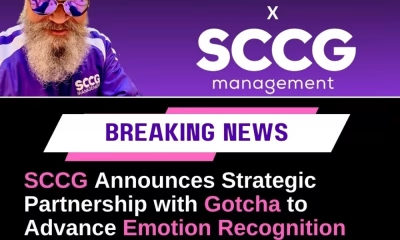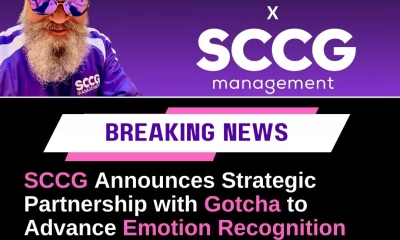Interviews
Cheltenham: Next steps for horse racing

Horse racing is one of the oldest activities in the world and the Cheltenham Festival is one of the spiritual homes of the sport. While the meeting is guaranteed to deliver strong engagement rates for UK-facing operators, there’s less interest among sportsbooks further afield in Europe. However, as horse racing continues to grow on the international stage, are European operators missing a trick by not identifying ways to make Cheltenham Festival and other UK meetings appealing to their own audience?
With the festival kicking off this week, European Gaming spoke to experts in the field on how the sport can make an impact internationally and the best practices required to make it relevant to a wider audience, while maintaining its status in the UK.
Alan Casey, CEO of AllSported
Adam Conway, Head of Trading at SIS
Dylan Casey Head of Paid Media, Checkd Media
Huge opportunities abound throughout the festival which brings a great deal of competition. How can horse racing operators make sure they stand out from the crowd during the event?
Dylan Casey: Too many operators allow their messaging to become like wallpaper throughout Cheltenham week. The ones who succeed are those that offer something unique or present their offer in a way that captures the customer’s eye and paid social advertising can allow operators to do just that.
A major advantage of paid social for horse racing operators is the guarantee of eyeballs and the sequencing of the messaging. The control of adverts being seen in a particular order can allow operators to get creative and even allow them to tailor the offer a customer sees based on their behaviour.
When running paid social for partner’s during the festival, we like them to refresh their messaging and offers daily. By tailoring it to certain races, horses or even jockeys, the messaging is always fresh and can help to avoid ad fatigue.
Not all operators will have the flexibility and resources to promote a different offer for each day of the festival. However, even if an operator’s offer isn’t unique enough to stand out, paid social advertising provides them with a huge opportunity to present that offer in a way that will allow them to do so.
Alan Casey: Content is king. Creating a sense of familiarity and comfort is all-important in cross-selling. Time and again, we see that racecards that feature plenty of content, predictions and ratings improve dwell time significantly.
However, even when an operator has this all-important content, how do they balance the integration times with the results? Separate integrations and multiple API feeds can take time and a lot of resources to put in place. It’s true that content is not always the priority compared to revenue-generating add-ons like cashing out, but without the content to engage customers, it’s likely a sportsbook will only get customers who are there to make a specific bet.
As well as that, consistency and balance matters a great deal, operators don’t need to be stand-out price every race, but an operator needs to be competitive in every race in terms of pricing and place terms. An operator can acquire a lot of customers by having the headline offer of the day or week, but it leaves the door open for customers to exploit that offer and leave.
Adam Conway: Aside from the traditional marketing techniques that operators adopt for the week of Cheltenham Festival, such as attractive promotional offers, offering a vast range of markets that are appealing to both existing bettors and newcomers is important. This includes the use of derivatives, which complement classic markets and allows those with little experience of racing betting to get involved.
Through our partnership with RACELAB we can offer the latest in trading technology which can help operators stay ahead of the smart money and offer prices at opportune times that standout from the crowd.
To what extent is there an appetite for UK horse racing outside the UK and Ireland? How does the sport need to adapt to appeal to this audience?
Alan Casey: From a customer perspective, there is a huge appetite, especially with regards to Cheltenham. It’s an easy sell with the best horses, jockeys and trainers on show and there are always magical storylines that capture the public’s imagination around the festival.
The obstacle for international operators is that the sport requires a huge level of expertise to work within it. The time and financial investment necessary to building a team to monitor the landscape is formidable.
The obvious solution is to outsource, but even then, there are pitfalls. It’s possible that an out-of-the-box service will leave an operator open to inaccurate pricing and following the exchanges blindly is dangerous based on liquidity and latency issues. It can be difficult to acquire and retain horse racing customers and even more so if there is no differentiation in the offering.
Operators need to invest in a flexible solution with a great deal of two-way communication. It’s vitally important to be able to react to your own customers’ bets and factor this into pricing. If an operator is reacting to the market alone, that lag will eat away at their bottom line.
Adam Conway: The cultural significance of major UK horse racing meetings means less for international operators and their customers, but there are still opportunities for non-UK sportsbooks to make the most of these events. The betting product needs be optimised differently for markets where there is less racing heritage, otherwise bettors are not going to be as likely to engage. This means promoting certain markets that can be more relevant to them. For instance, derivatives are becoming increasingly popular with international operators, with markets such as match betting and odds vs. evens far easier to understand. Ultimately, these types of markets don’t require as much insight into the sport itself, which encourages a wider audience to engage with the product. Horse racing needs to attract a new generation of bettors, and outside of the UK these kinds of markets are important to this approach.
Of course, establishing an in-house trading team to cover 24/7 racing events can be costly. In addition, the availability of traders that have the specialist knowledge required can be difficult to find in markets where there is a modest racing culture, which means they cannot efficiently manage pricing and risk. Our SIS Trading Services can help operators in these markets by offering them a fully outsourced solution that leaves the entire racing proposition in the hands of our experts.
How can international operators capitalise on UK horse racing meetings like Cheltenham Festival, which are proven to generate strong bettor engagement in its home market? What can domestic operators do to maintain a slice of the action amid such intense competition?
Adam Conway: One of the main challenges that UK operators face during major UK meetings such as the Cheltenham Festival is profitability. Promotions which include offers like extra places paid can impact the overall margins they can make. These sportsbooks require products and tools that can grow business and maximise margins. At SIS, we are working hard to make this possible by enhancing our Trading Services with the addition of next generation trading tools. In partnership with RACELAB, our traders now have the very latest technology advantage, ensuring we can stay ahead of the smart money and produce more intelligent prices. This includes the Odds Engine compilation software, which has the biggest breadth of content and the most sophisticated trader controls and the highest number of priced horses (including all the local pools).
For international bettors from regions where there is less racing heritage, we have found that it has been useful to offer additional levels of support to operators new to the sport. This means increasing the emphasis on those betting markets that are simpler to understand and don’t require specific in-depth racing knowledge. We can offer operators a managed trading service to help them manage their risk.
Alan Casey: A little education goes a long way. A huge number of people that aren’t full-time racing fans flock to bet on Cheltenham every year because of the status it holds. Investing in the right odds and pricing package that includes content as part of the deal can go a long way towards engaging these fans, as well as seasoned ones.
Cheltenham simply lends itself to this kind of content with some captivating narratives every year. Rachael Blackmore and Henry de Bromhead combining throughout last year’s event and taking the festival by storm stands out as a great example. There are always interesting narratives surrounding Ruby Walsh and Willie Mullins as well. It all captures the imagination and if international operators can gain the means to educate their customers on the ins and outs of the sport, they will be on to a winner.
Domestically, it’s about finding the right balance between trading and marketing teams. Consistency is essential in this product offering throughout the week. Single race odds boosts or acquisition offers don’t guarantee you a customer’s wallet for the four days of the festival or even for an entire day. The key is giving customers a choice of races that spreads out the positions more evenly and then helps the operator engage the customer in each race throughout the festival.
How is price latency and odds generation different in horse racing compared to other sports betting activities? What challenges does this present for operators?
Alan Casey: If we take a traditional sport like football, the teamsheets are announced an hour before kick-off and we see the market shifts as a result. Outside of that, there isn’t a lot of other information flowing into the market.
In horse racing however, there is more information in the market and operators are exposed from the minute they put bets up with no set times as to when information will enter the market. Latency issues become far more apparent in horseracing, dealing with large bets can result in loss of margin from a day’s racing. During the final minutes before the off, any latency or speed issue can result in operators being left badly exposed.
With the market constantly flocculating like this, Push APIs that inform operators the instant a price has changed can be invaluable, leaving no time for incorrect pricing on a sportsbook. Mere seconds of inaccurate pricing can be the difference between profit and loss.
Powered by WPeMatico
Black Cow Technology
Inside Black Cow’s Decision To Go All In On Multiplayer

Reading Time: 3 minutes
Black Cow Technology Founder and CEO, Max Francis, on why the company has shifted focus from software development to game development, and why he believes multiplayer is the future of online gambling entertainment
Black Cow has just announced its transition into a multiplayer content provider. What made you refocus the business in such a way?
We truly believe that multiplayer is the future of online gambling entertainment, and with our own technology capable of building next-gen multiplayer experiences, we wanted to transition into a content-led business and release some innovative games of our own. Our Multiplayer RGS is especially powerful, allowing operators and suppliers to bring multiplayer gameplay to any game format, even including non-gambling events. Black Cow’s robust, reliable and highly flexible technology is already used by some of the biggest organisations in the industry, including the likes of DraftKings and Light & Wonder. The shift into creating our own multiplayer content enables us to build on our successful Remote Game Server (RGS) and Jackpot Server technology to create first-of-its kind games offering unique player experiences via our Multiplayer RGS platform.
Tell us more about your Multiplayer RGS and its capabilities. What sets it apart from similar solutions in the market?
Our Multiplayer RGS has been several years in the making and is already live with Light & Wonder. Our Multiplayer RGS can be used to create multiplayer experiences across anything from slots and table games to crash, plinko, lottery, live dealer and bingo. Games can be player-cooperative or player versus player. The system’s capabilities are really only limited by the imagination of the people using it, and that’s why we’re so excited to be moving into the realm of game development so that we can push its limits to disrupt online casino lobbies with Black Cow content.
Taking a business in a new direction is a significant undertaking, not without its risks. How have you approached this transition?
It was clear to me that we had the technology to create multiplayer content, but not necessarily the experience to date, and that’s why we’ve been making strategic hires. This year we have promoted Paul Jefferson to the role of Chief Technical Officer and we have welcomed two more big-hitters to the business – Ernie Lafky as Chief Product Officer and Shelley Hannah as Chief Operations Officer. Ernie is taking the lead when it comes to what our games will look like and how we combine key elements like multiplayer, gamification and social interaction. Shelley is managing the operational aspects of our transition to a hosted product-first model. In terms of mitigating the risk, it comes down to the deep rooted confidence we have in our technology and our fantastic team, plus our belief that players are seeking social multiplayer entertainment.
Why do you have such a firm belief that multiplayer content is the future? And to what extent will it dominate online casino game lobbies?
It’s not the future, it’s the now. You just have to look at the experiences offered by other online entertainment options to see that they are becoming increasingly multiplayer and social. From dating to streaming, social media to mobile gaming, consumers want to engage with products and experiences that can be enjoyed with others. But online casino and sports betting sit at odds with this as they have been, and remain, mostly solitary experiences. We have started to see a bit of a shift away from this, first with live casino and then the rise of the crash game format. But this is just the start of what multiplayer online gambling entertainment can look like, and at Black Cow we have the vision, people and technology to really spearhead the multiplayer movement and be a true leader in the space.
As for the degree to which multiplayer content will dominate online casino and sportsbook lobbies, I think it has the potential to be significant but there will always be players that want to engage with more traditional games, products and experiences, so it will be down to each operator as to how they promote multiplayer games. Naturally, this approach will differ from brand to brand based on their specific player-base.
What can we expect from Black Cow now that your transition into a multiplayer game developer is well underway?
Paul, Ernie, Shelley and the team are working hard on our initial product roadmap, including the first run of games that will leave our production line. This is a really exciting moment for me and the whole team, as it will bring our vision to life and set the blueprint for what our multiplayer games will look like moving forward. It goes without saying that our multiplayer games will embody the core values we have built Black Cow on – reliability, flexibility and robustness. This is a big change for Black Cow, and change does bring challenges. But we are all aligned and excited by the new direction. Success is never guaranteed, but we are walking into the next chapter of the Black Cow story confident that it will be our best yet.
The post Inside Black Cow’s Decision To Go All In On Multiplayer appeared first on European Gaming Industry News.
Interviews
Scaling With Purpose: RedCore’s Tech Vision Explained

Reading Time: 7 minutes
At SiGMA Central Europe in Rome, European Gaming Media sat down with Yevhenii Yankovyi, Vice President of Technology and Deputy CTO at RedCore, for a deep look into what truly powers RedCore’s large-scale engineering operations.
RedCore is known for innovating at enterprise level, yet moving with the agility of a fast-growing tech company. In this conversation, Yevhenii breaks down how the organization manages that balance: how engineering teams maintain both speed and reliability, how automation empowers creativity, and why culture must remain a daily practice rather than a one-time achievement.
Can you introduce yourself and RedCore’s approach to engineering at scale?
Sure. My name is Yevhenii, I’m the Vice President of Technology at RedCore and Deputy CTO. RedCore is a large company with many products and projects, so everything we do operates at a significant scale. And when people hear “enterprise-level engineering,” the usual assumption is that scale automatically means slowness: slow decision-making, slow implementation, slow testing, slow time to market.
That’s the mindset we challenge. We don’t believe speed and stability are opposites. In our experience, at this level of complexity, the two actually reinforce each other. When you build the right processes, the right technical foundations, and the right organizational structure, speed becomes a natural result of stability – not something that contradicts it.
We plan for scaling from day one. For us, that’s a fundamental requirement. We build products with the expectation that they will grow, and growth means scale. So we design with that in mind from the very first line of architecture.
But that doesn’t mean disappearing for six or ten months to design the “perfect” system. That’s the common mistake people make when they hear “design for scale.” Our approach is different: we keep the long-term vision in mind, but we move fast, iterate, and make sure the product can evolve without slowing the team down. Stability and speed working together – that’s the engineering culture we build at RedCore.
How does RedCore balance speed and stability in daily engineering?
I will explain this with a simple metaphor: think about a car. Everyone talks about acceleration and top speed, but none of that matters if you can’t take a corner. Speed alone is not the winning formula – you also need control.
That’s exactly how we look at engineering at RedCore. We want to accelerate, make decisions quickly, and develop fast. But we also need the ability to slow down at the right moment, change direction, and stay agile. Balancing speed with stability is the only way to move at scale.
There are many layers to this – it’s a topic I could talk about for days – but in a nutshell:
at a big scale, you must have strong standards, clear policies, and a high level of automation. We rely heavily on automation: infrastructure as code, CI/CD pipelines, automated testing, and all the tools that remove repetitive, routine work from engineers’ daily lives. When the routine disappears, people can focus on what humans actually do best: creativity, problem-solving, and innovation.
However, automation doesn’t build the software for you. It creates a safety net. It catches mistakes, guards quality, and supports engineers when their creativity pushes boundaries. In other words: tools give freedom, and also protect that freedom.
And of course, this includes AI and many other modern tools. We use whatever helps us keep the balance: give people space to think, create, and experiment, while ensuring the system stays stable, predictable, and high-quality.
How does RedCore’s management keep teams aligned yet fast?
First of all, we provide clear goals. As I mentioned earlier, we always design for scale from day zero – but you can only do that if you know exactly what you’re building, for whom, and why. We have a very strong business team that understands the market and what needs to be delivered. The technology team works side by side with them, reinforcing them.
Once the goals are clear, we begin small. If you try to build a huge system from the beginning and get it wrong, you create a nightmare: something no one can support, change, or grow. Complexity grows exponentially, and humans don’t think exponentially; we think linearly. That’s where companies often get lost.
So we avoid that by validating early and validating often. We start with small steps, keep a close eye on every direction we take, and confirm that what we’re building is truly needed by the market. When we see that the direction is right, then we scale – and by that point, the foundation is already in place. It’s like preparing a launchpad so that when the time comes, the team can accelerate immediately.
We build block by block and work in iterations. We take a small team – one, two, maybe three people – and let them experiment for a week. We test the idea fast, get quick feedback, and bring it to the business side: “Do you like it?” If the answer is yes, then we continue, still following all the proper engineering practices before anything goes into production.
This constant loop between business and technology keeps everyone aligned. We give feedback, we receive feedback, and we move together. That’s how we stay both fast and coordinated, always ready to scale when the direction is confirmed.
How does automation empower engineers without slowing them down?
When we talk about automation, we’re really talking about optimization at scale. It doesn’t make sense to over-engineer small things, but at the scale we operate, the cost efficiency and speed gains are enormous. And people often assume that big systems and automation automatically slow everything down. For us, it’s the opposite.
The tools we introduce are not meant to tie engineers’ hands with bureaucracy. We don’t force strict guidelines or heavy processes that kill creativity. Our tools exist to help: to prevent mistakes, to collect feedback quickly, and to give teams the shortest possible path from idea to validation.
Here’s a simple example: we start experimenting with a small feature. We build a tiny prototype to see if the idea works. If it’s promising, the next step is testing, pipelines, deployment – all the things that normally take time. In many companies, engineers would try to do all of this manually because “building the tools will take too long.” But with us, the tools are already there. The infrastructure, the CI/CD, the automation – everything is ready to use. Our engineers are essentially customers of this internal platform that supports fast, safe delivery.
We have many different teams that have different great ideas. If one team tries something new and it works better, great – we learn from it. If another team has a different approach because of product specifics or release schedules, that’s fine too. We give freedom to the teams to work, share their experiences, and then scale.
Of course, there are non-negotiables. When it comes to security and data privacy there is zero tolerance. These are areas where strict rules are absolutely necessary. I always tell the security people: everyone should be a little afraid of you, because these things must be perfect. But outside those critical areas, we don’t impose rules that slow teams down. We experiment, gather feedback, adjust, and keep improving.
We’re constantly researching, experimenting, and customizing our automation depending on the product and the market. But when it comes to system design, we don’t reinvent the wheel. We choose globally recognized tools and industry-validated technologies. So yes, we empower engineers with automation and the right tools, built on a solid, modern foundation.
How does culture work for you – is it an achievement, or part of your routine?
Culture is a critical element in balancing speed and stability. Tools and processes matter, but culture is what truly empowers a team and keeps everything together at scale.
For us, culture starts with giving people freedom: the freedom to experiment, the freedom to make mistakes, and the freedom to challenge ideas. We don’t want engineers to be afraid of trying something new. We build a culture where mistakes are acceptable and manageable. If we try something and it doesn’t work, great – now we know better. We learn, adjust, and move on.
We encourage ideas from every level. Some of our most interesting insights come from developers who notice something while working on a small task. They can come directly to me or to the CTO and say, “I see a problem here.” It’s completely okay. A small detail in one corner of the system can become a huge issue at scale, so we listen. That’s how we avoid blind spots.
We also give teams autonomy. Small teams can make their own decisions and experiment in their own ways. If different teams want to do things differently, that’s fine – as long as they validate everything and share their findings. We want people to help each other and to understand that even top engineers have ups and downs. Even senior management makes mistakes. I constantly ask my team: “If I make a wrong decision, tell me.” It’s not about transparency as a buzzword – it’s about behavior. People observe how you respond, and they learn from that.
The biggest mistake any leader can make is demotivating people. We work with intelligent, educated, passionate professionals. They want to contribute. You just need to give them the space to do it. That’s when you see people shine and bring forward brilliant ideas.
As for the question of whether culture is an achievement or a routine – for us, it’s definitely a routine. People often talk about “building a strong engineering culture” as if it’s a success. We treat it as a routine as a process. Culture is the daily interactions between people in an organization. Those interactions change: people come and go, someone has a bad day, someone disagrees with a decision. Culture is shaped every day by how we communicate, how we argue, how we respect each other, and how we resolve differences.
Going to a colleague in the kitchen and asking, “Hey, what do you think about this?” – that’s culture. Anyone can talk to anyone, openly. And when engineers realize they can make a real impact, that they are heard, that they can influence the product — that motivates them. That’s what keeps the culture alive.
How do you balance standards with creative freedom?
The first thing is that we don’t pressure people. We set strict standards only where they are truly critical for the business. Security, data privacy, stability at scale – those areas demand clear rules. But everywhere else, we try not to push people. And when we do introduce a standard or guideline, we listen carefully to feedback. If the team tells us we made the wrong call, that’s okay – we rethink it and look for better approaches.
The second thing is that as the projects grow, the teams scale as well. Even in the design phase, we don’t start with a huge team. I prefer a small group: one key person who leads the design initiative, plus two or three contributors who constantly review, test, question, and give feedback. If three or four people align in one direction, that’s a good signal we’re on the right track. Then we take that proposal to a larger group – people who might use it or need it.. We refine it again based on their input. The idea evolves, but we don’t need to start from the beginning.
Finally, when we have a strong direction, we present it to the entire tech team. And even then – even if top management already supports the decision – it’s completely acceptable for a mid-level developer to raise concerns. Maybe they’ve seen something before, maybe they read an article, maybe they faced a similar issue. We listen, because at scale, one overlooked detail can cost millions.
So once again, balancing standards with creative freedom is about scaling the processes step by step: we start with a small group, validate in small cycles, and then scale the decision up gradually. This approach protects creativity, ensures high quality, and keeps us aligned. And combined with our culture, it makes the process both fast and safe.
The post Scaling With Purpose: RedCore’s Tech Vision Explained appeared first on European Gaming Industry News.
HIPTHER
How to Write a CV that Attracts Top Employers – Insights by Valeriia Virchenko, Head of Talent Acquisition at RedCore

Reading Time: 4 minutes
European Gaming Media joined RedCore and Valeriia Virchenko, Head of Talent Acquisition, at their SiGMA Central Europe booth in Rome to discuss a topic that resonates with every ambitious professional: how to write a CV that truly stands out to top employers.
As an accomplished recruitment leader with extensive experience across continents – from Europe to Latin America, Africa, and Asia – Valeriia brings a global perspective on what leading companies seek in candidates today. Under her leadership, RedCore’s talent acquisition strategy continues to attract and develop exceptional professionals across tech, marketing, and fintech.
Interview by Maria Emma Arnidou, HIPTHER – European Gaming Media
Valeriia, from your experience leading large-scale recruitment projects across international markets, what makes a CV truly stand out to top employers today?
First of all, thank you for the invitation. From my experience, what really makes a CV stand out is when candidates clearly show their results and impact. Top companies want evidence of what you achieved, not just a list of responsibilities. It’s important to include metrics or numbers – for example, not just “I managed a large team,” but “I led a team of 15 and increased results by 20%.” These details matter. Employers want to see how your experience directly helped solve problems or improved something within the company.

What are the most common mistakes candidates make when writing their CVs, and what advice would you give them to avoid these pitfalls?
This is a big topic, but in my opinion the most common mistake is that some CVs are simply too long. Hiring managers can only scan a CV briefly, so two pages, three at most, is enough. Writing a very long CV is a major mistake. Another point is simple but often overlooked: candidates really need to proofread their final draft. Small errors and little details matter because they show whether someone is attentive and pays attention to detail.
When reviewing applications at RedCore, what qualities or signals do you look for that show a candidate is ready to grow within a fast-paced, innovation-driven environment?
We mainly look for two things. The first is adaptability – people who can adjust quickly to change. The second is a genuine love of learning. We prefer hiring people with a growth mindset. How fast someone can learn new tools or approaches is very important for us, because our industry is extremely dynamic. If a person doesn’t like learning or isn’t open to new technologies, it becomes difficult to work together in such an environment.
On a CV, it helps a lot when candidates highlight this. If you started a new project, learned a new tool quickly, or solved a significant problem at work – mention it. These signals show us that you’re ready to grow with us.
RedCore is actively hiring specialists across various sectors – also C-level professionals. What can experienced candidates expect when joining your organization in terms of career growth and support?
We can talk about perks, benefits, high salaries – and of course we have all of that – but so does everyone. What I really want to highlight, especially for C-level candidates, is something different. If you look at our booth here at SiGMA Central Europe, you can see how big it is – because it houses the many brands : Mr. Booster, Frogo, PayPartners, and others. Each of these brands has its own C-level professionals, and these leaders grow inside our company.
What we offer C-level professionals is ownership and creative freedom: the opportunity to act like business owners. They can take a product from idea to market, understand what needs to be done, build the right sales strategy, and really drive the product forward. They get the freedom and responsibility of running a business, but in a comfortable environment and with minimal risk. You can focus purely on growth and vision.
And one more thing that’s very important for us: we always welcome C-level candidates to visit our booth at expos. We want to meet them, to get to know them, even if they are not actively looking for a new role right now. There are always opportunities, and we are always open to talent.

Finally, for those aspiring to join global companies like RedCore, what’s your number one piece of advice for crafting a CV that stands out and secures an interview?
Be very clear about your sector. If you work in fintech, iGaming, healthcare – mention it right away, because it immediately gives us an understanding of your background. These industries are not the same, and this context matters. The same goes for technical roles: if you’re a developer, list your full tech stack clearly. Which technologies, which tools – everything should be easy to find.
Structure and presentation are also important. It’s better to build your CV using a proper layout tool like Canva or Tilda, rather than leaving it as a plain Google Doc. Think of it like a user journey: recruiters and hiring managers should instantly know where to find the right information about you.
And finally, include a photo: a simple, professional portrait. Sometimes we see funny photos, and that’s not the impression you want to give when applying to a global company. You don’t need a studio shoot; even a phone photo taken against a white or grey wall is enough. People want to see who they might be working with in the future.
Thank you, Valeriia, for sharing your valuable insights on building a career-ready CV and giving us a closer look into RedCore’s approach to talent and professional growth.
RedCore is hiring – View the job openings & build your dream career with them!
Stay tuned for more exclusive interviews from SiGMA Central Europe 2025, brought to you by European Gaming Media, your trusted source for insights at the intersection of iGaming, tech, and innovation.
The post How to Write a CV that Attracts Top Employers – Insights by Valeriia Virchenko, Head of Talent Acquisition at RedCore appeared first on European Gaming Industry News.
-

 Belatra Games6 days ago
Belatra Games6 days agoFrom ‘Mummyverse’ to Crash Games: Belatra Reviews a Landmark 2025
-

 BMM Testlabs7 days ago
BMM Testlabs7 days ago‘Chaos and Soul’: Ebaka Games Plots Global Expansion After Viral Launch
-

 Anushka Bhatnagar7 days ago
Anushka Bhatnagar7 days agoFrom Rolling Loud to Riot Games: How 2025 Became the Year of Indian Gaming
-

 Behavioral Analysis7 days ago
Behavioral Analysis7 days agoSCCG Bets on ‘Emotion AI’: New Tech Can Read Player Faces for Trust & Fraud
-

 ARC7 days ago
ARC7 days agoRacing Meets Nightlife: SBK Backs ARC’s New ‘Friday Night Live’ Series
-

 BETER7 days ago
BETER7 days agoBETER Secures Vendor Registration in Florida
-

 AbraCadabra7 days ago
AbraCadabra7 days agoQTech Games Adds Africa’s ‘Crazy Rocket’ Hitmaker AbraCadabra to Platform
-

 African Casino Market7 days ago
African Casino Market7 days agoNairobi’s Simba Casino Upgrades Floor with EGT’s ‘General Series’ VIP Cabinets



















